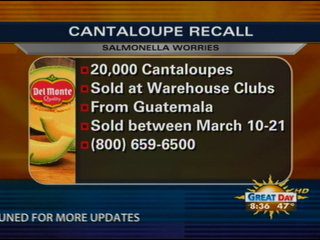

On episode #4 of the podcast This Week in Microbiology, Vincent, Cliff, Margaret, and Michael review foodborne bacterial illness in the context of outbreaks associated with cantaloupes and Lebanon bologna.
[powerpress url=”http://traffic.libsyn.com/twimshow/TWiM004.mp3″]
Click the arrow above to play, or right click to download TWiM #4 (51 MB .mp3, 75 minutes).
Subscribe to TWiM (free) on iTunes, Zune Marketplace, via RSS feed, by email or listen on your mobile device with the Microbeworld app.
Links for this episode:
- CDC statement on Salmonella outbreak
- CDC statement on E. coli outbreak
- CIDRAP summaries of cantaloupe and bologna associated outbreaks
- ProMedMail summary of Salmonella outbreak
- Summary of food related illness in US (pdf)
- Food safety and irradiation (CDC)
- Geosmin (thanks, Atila!)
- Letters read on TWiM #4
Send your microbiology questions and comments (email or mp3 file) to twim@microbe.tv, or call them in to 908-312-0760. You can also post articles that you would like us to discuss at microbeworld.org and tag them with twim.

I recall hearing about a bacterial contamination of cantaloupe years ago, which is when I started to wash them in soapy water before slicing.
Of course, I try to follow the rules. We actually cut meat products on the counter between the stove and sink, and the rest on the kitchen island to prevent cross contamination. Often I will prep for cooking by cutting the veggies on a dishwasher proof cutting board on the island, put them in bowls and set aside. Then move the cutting board to the counter, cut the meat and either put it in the bowl or the pan. Then put the cutting board in the dishwasher, set the knife to be hand washed next o the sink. Then cooking is quicker because I have everything ready, using a food safe mise a place.
The other day I was watching an old cooking show with Julia Child. I just about gagged when I saw the other chef she was working with put an herb stuffing between the breast and skin, and then reach over to pick up salt from a bowl with his fingers without washing his hands or using a spoon!
I have a TWiM idea from watching cooking shows, especially one that showed all of the varieties of salt: pink salt, which gets its color from an extremophile bacteria (a tidbit I want to share at the local upscale kitchen store when I get a chance!). Oh, cool, just checking the halophile wiki, I learned they are essential for some fermented foods like soy sauce, sauerkraut, anchovies, etc:
http://en.wikipedia.org/wiki/Halophile